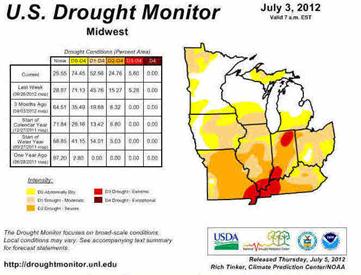The current dry spell in much of the Midwest raises some challenges the fledgling bio-products industries will face now and in the future. There are still some who believe the biomass material is just "extra" material that has no other potential use. For livestock producers and dairy farmers that isn't the case. When alfalfa production is down some of the choices are chopping distressed row crops for silage (there goes the stover) or using the stover to supplement feed rations.
 Much of the bio-mass rich area of the Midwest is under stress right now as shown by a recent report from the National Drought Mitigation Center in Lincoln, NE. Only time will tell if these areas receive enough precipitation to produce a harvest this year. At any rate the amount of bio-mass available from these areas has already been reduced by the hot dry weather.
Much of the bio-mass rich area of the Midwest is under stress right now as shown by a recent report from the National Drought Mitigation Center in Lincoln, NE. Only time will tell if these areas receive enough precipitation to produce a harvest this year. At any rate the amount of bio-mass available from these areas has already been reduced by the hot dry weather.
While some crops grown specifically for bio-mass production such as switchgrass and miscanthus are drought resistant, the yields will be adversely affected in drought areas.
Production scale Bio-mass conversion facilities need a steady supply of feedstock to maintain planned production levels. The further away from the facility you go to source your feedstock the greater the pressure on earnings from higher transportation costs. Knowing where they can go to expand their sourcing circle can help these facilities manage these additional costs.
At Decision Innovation Solutions we have seen recent interest in utilizing a bio-mass mapping tool using a methodology that incorporates economic factors, local cropping practices, soil types and topographical information to identify areas that offer the best potential for bio-mass feedstocks. Existing and planned facilities both need a back-up plan to offset the occasional reductions in feedstock for their operations. Mapping an area to learn its potential can make a valuable contribution to developing a feedstock backup plan.

